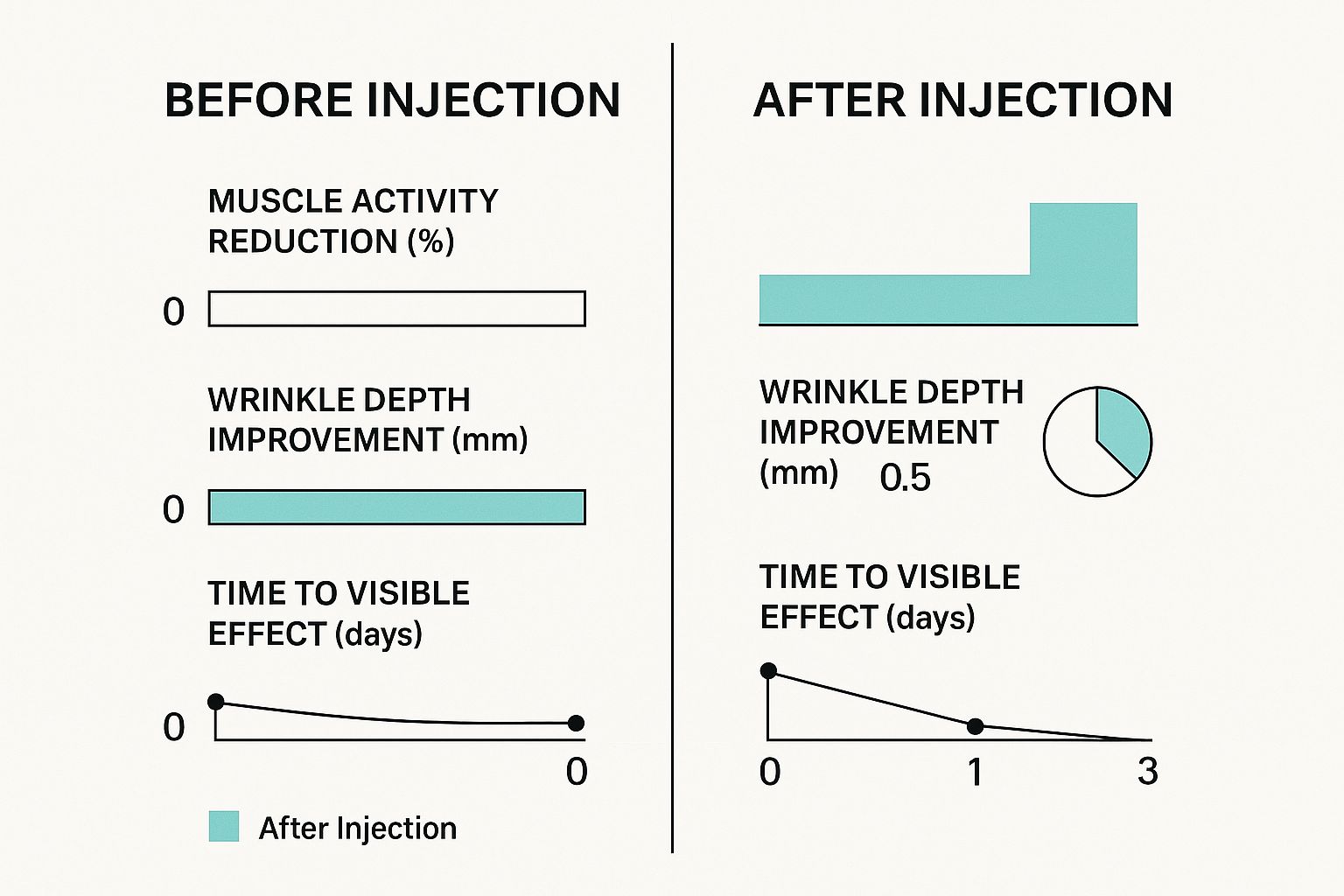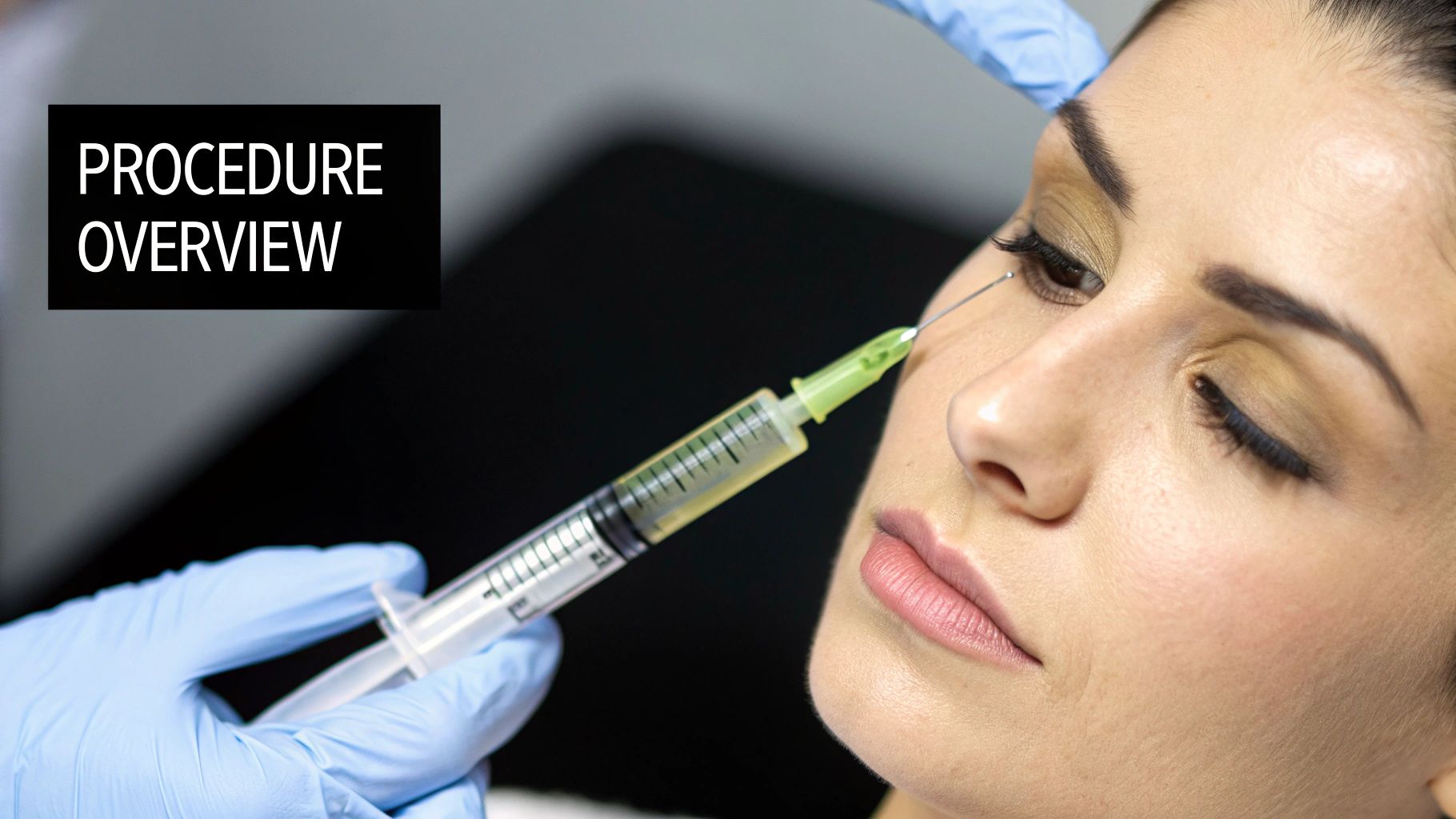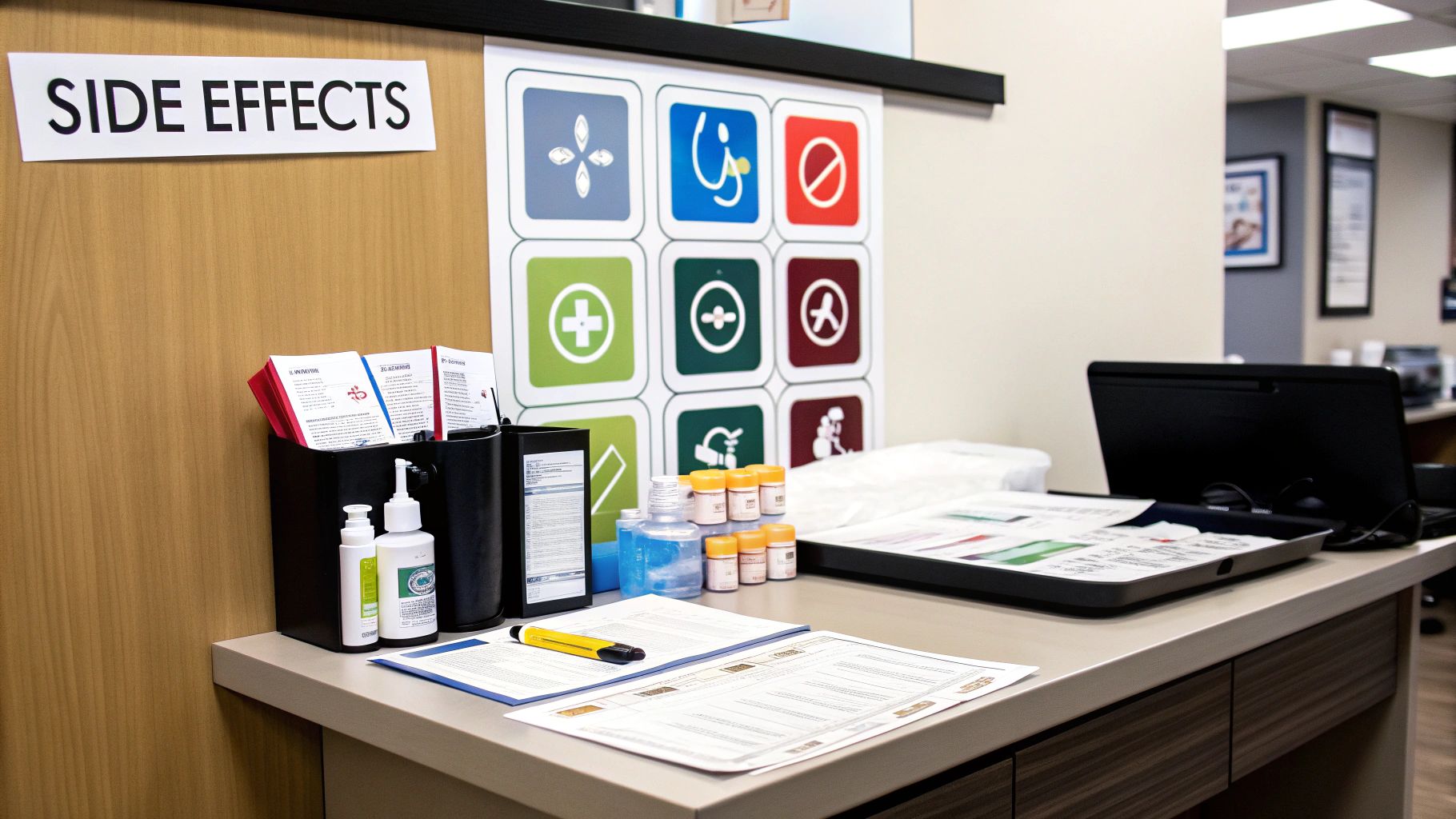What Are Anti Wrinkle Injections? Complete Expert Guide
- Charis Aesthetics
- Jun 22, 2025
- 12 min read
Updated: Jun 24, 2025
Understanding What Anti-Wrinkle Injections Actually Do
To get a clear picture of what anti-wrinkle injections are, think of your facial muscles as tiny, hard-working engines. Over the years, every smile, frown, and surprised look has been powered by these engines, slowly creating fine lines in the skin above them. These injections work like a dimmer switch, not shutting the engines off completely, but gently dialling down their activity in specific areas. This gives the skin a chance to relax and smooth out, softening existing lines and helping to prevent new ones from forming.
The science behind this involves a purified protein known as Botulinum toxin. You can think of it as a temporary signal blocker. When carefully injected, it interrupts the messages sent from your nerves to certain muscles, effectively telling them to take a break. This is especially useful for dynamic wrinkles—the ones that appear when you move your face, such as crow's feet or forehead lines. By pausing these repetitive muscle movements, your skin gets a much-needed rest.
The Science of Smoothing
At its core, Botulinum toxin works by preventing the release of a chemical messenger called acetylcholine, right where nerve endings connect with muscle fibres. Without this messenger, the muscle simply doesn’t get the instruction to contract. This microscopic process is shown in the image below, which illustrates how the toxin blocks the nerve signals that cause muscles to clench.

This image helps explain how the toxin leads to the temporary muscle relaxation that smooths away wrinkles. When administered by a qualified professional, its effectiveness and safety profile have made it a leading choice for facial rejuvenation. The scale of its popularity is clear from market data; the UK facial injectable market was valued at around USD 451.5 million in 2024, with Botulinum toxin treatments making up a massive 55.08% of that. You can read a full UK market analysis on Grand View Research.
This growth highlights how these injections have become a routine part of many people's self-care. By precisely addressing the cause of expression lines, they offer a way to manage the signs of ageing while keeping a natural appearance. If you're considering this for yourself, learning about what the procedure involves can provide extra peace of mind. For more detailed information, feel free to explore our complete guide on anti-wrinkle injections.
Exploring Your Options: From Botox To New Alternatives
Choosing an anti-wrinkle injection is a bit like picking the right tool for a specific job; they aren't all the same. While Botox is the brand most people recognise, other neurotoxins like Azzalure and Dysport are also common, each with its own unique properties. Think of them as different brands of paracetamol—they share the same active ingredient but can have slightly different effects. Some might work a little faster or spread differently under the skin, making one a better choice for certain facial areas or muscle types.
For instance, a practitioner might prefer one brand for treating delicate crow's feet because of its subtle spread, while another might be better for tackling stronger forehead muscles. These small differences can have a noticeable impact on your final look. This is why a thorough consultation is so important—it allows your practitioner to match the product to your specific needs for a natural and effective result. Many people find that treating multiple areas together, like the forehead and frown lines, creates the most balanced appearance. You can learn more about how a treatment for three areas can produce a harmonious effect.
To help you understand the main options, here’s a breakdown of the most popular types of anti-wrinkle injections.
Comparison of Popular Anti-Wrinkle Injection Types
This table offers a side-by-side comparison of different injection types, their active ingredients, typical duration, and best applications.
Treatment Type | Active Ingredient | Duration | Best For | Onset Time |
|---|---|---|---|---|
Botox | OnabotulinumtoxinA | 3-4 months | Strong facial muscles like the forehead and frown lines | 7-14 days |
Azzalure/Dysport | AbobotulinumtoxinA | 3-4 months | Larger areas like the forehead and crow's feet due to wider diffusion | 2-5 days |
Bocouture/Xeomin | IncobotulinumtoxinA | 3-4 months | Patients who have developed a tolerance to other toxins; smaller muscles | 4-7 days |
Polynucleotides | Polymerised Polynucleotides | 6-9 months | Improving skin quality, fine lines, hydration, and under-eye circles | Gradual, over several weeks |
This comparison shows that while traditional neurotoxins are excellent for targeting specific muscles, newer regenerative options like polynucleotides focus on improving the overall health and structure of the skin itself.
The Rise of Regenerative Treatments
Beyond just relaxing muscles, a new class of treatments is gaining traction for its ability to improve skin health from the inside out. This is where regenerative options like polynucleotides enter the picture. Instead of just pressing pause on muscle activity, these injectables work at a cellular level to kick-start your body’s own repair systems. They encourage the production of collagen and elastin, leading to better skin thickness, hydration, and texture.
The infographic below shows the direct effects of traditional neurotoxin injections on muscle activity and wrinkle depth.

As you can see, these treatments are highly effective at stopping muscle movement and smoothing the skin's surface within days. Now, this approach is being combined with treatments that also repair and rebuild. The UK's anti-ageing market is showing a clear move towards injectables that boost skin health while also reducing wrinkles. Looking ahead, treatments such as polynucleotides are expected to become more widespread as they help repair skin at a cellular level, a key trend highlighted in these 2025 aesthetic medicine insights. This dual approach—relaxing muscles while actively improving skin quality—offers a more complete strategy for long-term skin health.
What Actually Happens During Your Treatment
Walking into your first appointment for anti-wrinkle injections can feel a little intimidating, but the reality is surprisingly straightforward. Many people describe the entire process as being less bothersome than a standard blood test or flu jab. It’s a quick and highly precise procedure, focused entirely on achieving a natural-looking result that works with your unique facial expressions.
The Consultation and Mapping Phase
Before any needles are involved, your practitioner will start with a detailed consultation. This is your time to discuss what you’d like to achieve, point out the areas that concern you, and ask any questions. A skilled practitioner will then ask you to make various expressions—frowning, smiling, raising your eyebrows—to observe how your facial muscles move.
Think of this as a tailor taking your measurements before cutting the fabric. They will carefully mark strategic points on your skin. These marks are not random; they pinpoint the exact spots where tiny injections will have the most impact, relaxing the targeted muscles without affecting your ability to show emotion naturally. This facial mapping is a critical step that separates an expert practitioner from a novice, ensuring the outcome looks refreshed, not frozen.
The Injection Process Itself
The actual injections take only a few minutes. Your practitioner will use an extremely fine needle to administer small amounts of the product into the marked points. Most people report feeling a quick, tiny prick, similar to a pinprick. In more sensitive areas, like around the eyes, it might feel like a tiny, brief snap, but the discomfort is minimal and over almost instantly.
A practitioner's expertise is vital for both safety and results. For example, the NHS provides clear guidance on what to expect from cosmetic procedures, which you can see in the screenshot below.
This guidance highlights the importance of understanding the procedure and post-treatment expectations, reinforcing that you should feel fully informed and confident in your practitioner’s hands throughout the entire process. After the last injection, your practitioner will provide you with aftercare instructions to ensure you get the best possible outcome from your treatment.
The Surprising Benefits You Never Expected
While smoother skin is the most famous outcome, anti-wrinkle injections offer a range of benefits that often catch people by surprise. Many discover these treatments do more than just soften lines; they can subtly improve your overall sense of well-being. For instance, a notable number of people report a drop in chronic tension headaches or migraines, as the injections relax the very forehead and brow muscles often linked to this discomfort.

This feeling of relief isn't just physical. Many individuals find their confidence gets a significant boost. Looking refreshed and less tired can have a powerful psychological effect, helping you feel more self-assured in professional and social settings. The aim isn’t to look like a different person, but to appear as the best version of yourself—well-rested and vibrant.
More Than Just Wrinkles: Medical and Preventive Perks
The benefits of Botulinum toxin stretch into medical applications, which is actually where its story began. Beyond the world of cosmetics, it's a recognised treatment for several conditions:
Hyperhidrosis: It effectively reduces excessive sweating in areas like the underarms.
Bruxism: It helps to relax the powerful jaw muscles, offering relief from teeth grinding and the associated jaw pain.
Muscle Spasms: It’s used to treat conditions that involve involuntary muscle contractions, such as blepharospasm (uncontrollable eye twitching).
Furthermore, a forward-thinking approach called ‘prejuvenation’ is becoming increasingly popular. This involves starting treatments earlier in life to stop deep, set-in wrinkles from forming in the first place. Younger patients are starting to see these injections as a form of preventative skincare rather than purely a corrective measure. This proactive mindset helps maintain smoother skin for longer, often meaning that less intensive treatments are required later on.
To help you understand what happens after an appointment, here is a typical timeline of the effects.
Timeline of Anti Wrinkle Injection Effects
Here's what to expect at different stages after your treatment, from the initial hours to the long-term results.
Time Period | What to Expect | Do's | Don'ts | Normal Symptoms |
|---|---|---|---|---|
First 24 Hours | You won't see much change yet as the product starts its work. | Stay upright and gently exercise your facial muscles (frowning, raising brows). | Avoid rubbing the area, strenuous exercise, and alcohol. | Minor redness or small, temporary bumps at the injection sites. |
Days 3-7 | You'll start to see a noticeable smoothing of lines and wrinkles. | Continue your normal skincare routine, but be gentle. | Avoid facials, facial massages, or anything that puts pressure on the area. | A slight headache or a feeling of tightness in the treated muscles. |
2 Weeks | The full effect is now visible. Your skin appears significantly smoother. | Attend your follow-up appointment if one was scheduled. This is the best time to assess results. | Don't worry about any minor asymmetries before this point, as things are still settling. | A settled, natural-looking result with reduced muscle movement. |
3-4 Months | Muscle movement will gradually start to return as the product wears off. | Schedule your next appointment to maintain your results seamlessly. | Avoid waiting until all your lines have fully returned before re-booking. | The slow and gradual return of your original expression lines. |
This timeline shows that while the procedure is quick, the results unfold over a couple of weeks. Following the aftercare advice is key to achieving the best possible outcome from your treatment.
Real Talk About Risks And What Can Go Wrong
Let’s move past the standard medical disclaimers and have an honest conversation about the concerns you might actually have. Yes, anti-wrinkle injections come with potential risks, but understanding them is the key to making a confident decision. The good news is that serious complications are extremely rare, and most side effects are minor and temporary. It helps to think of these as your body’s normal, predictable response to any injection, not a sign that something is amiss.
The "horror stories" you might see online are almost always the result of unqualified individuals performing treatments, not an inherent flaw in the product itself. Choosing a medically qualified practitioner with a deep understanding of facial anatomy dramatically reduces the chance of anything going wrong. When administered correctly, these treatments have a very high safety profile.
Common Side Effects vs. Rare Complications
It’s important to distinguish between what’s normal and what’s not. Most people will only experience mild, short-lived side effects that resolve on their own within a few days. These are completely normal signs of your skin healing after the procedure.
Common and Temporary Side Effects:
Minor Bruising: Small bruises may appear at the injection sites, especially in delicate areas. This is easily covered with makeup and fades quickly.
Slight Swelling or Redness: The treated area might look a little puffy or flushed for a few hours post-treatment. This is just your skin’s initial reaction.
Temporary Headaches: Some people experience a mild headache on the day of their treatment, which usually subsides within 24 to 48 hours.
A Feeling of Heaviness: A temporary sensation of tightness or heaviness in the forehead or brows is also common as the product begins to take effect.
When to Be Concerned
While very uncommon, more significant complications can occur, almost always linked to injector error. These are the issues that require an immediate follow-up with your practitioner.
Rare but Serious Risks:
Eyelid or Brow Ptosis (Drooping): This happens if the product migrates from the intended muscle, causing a temporary droop in the eyelid or brow. While it’s the most-discussed risk, it occurs in less than 1% of cases with experienced injectors.
Asymmetry: Uneven results where one side of the face appears different from the other. This can often be corrected with a small touch-up at your follow-up appointment.
Blurred or Double Vision: An extremely rare complication that requires immediate medical attention.
The most critical factor in preventing these issues is the skill of your practitioner. An expert knows precisely where and how much to inject to avoid affecting nearby muscles. This is why paying for expertise at a clinic like **Charis Aesthetics** is an investment in your safety and your results.
Who's Really Getting These Treatments in the UK?
The picture of someone getting anti-wrinkle injections has changed completely. It's no longer a treatment reserved for celebrities or the super-wealthy. Instead, today’s patient is much more likely to be a teacher, a nurse, an accountant, or a retiree. For many, these appointments have become a normal part of their self-care routine, just like a trip to the dentist or a haircut. The goal isn't about chasing an unrealistic ideal of youth, but simply about feeling refreshed and confident.

A Shift in Demographics and Motivation
This change is all about real-world needs. Think of the busy professional who wants to appear less tired for a big presentation, or the parent who, after years of putting their children first, decides it's time to do something for themselves. The decision to get anti-wrinkle injections has gone from a whispered secret to an open choice for personal well-being. This normalisation is supported by the growing professionalism and regulation within the UK aesthetics industry.
With clearer training standards and better oversight, people feel much safer exploring their options. This widespread acceptance has made treatments more accessible, which has had a knock-on effect on everything from pricing to the range of procedures on offer. The statistics show just how mainstream these treatments have become. In 2023, around 7.7 million people in the UK, or about 11% of the population, had an aesthetic treatment. A large number of these were anti-wrinkle injections, provided by nearly 3,924 clinics and 7,892 licensed practitioners. You can read more about the UK aesthetics industry's impressive growth on Policybee.
Who Are the Typical Clients?
The client base for these treatments is now incredibly varied, shattering old stereotypes. It includes:
Young Professionals: Many people in their late 20s and early 30s are now using injections as a preventative step to stop deep lines from forming in the first place.
Working Parents: Juggling careers and family life, these individuals want to look as energetic on the outside as they feel on the inside.
Men: This is a rapidly growing group who are seeking subtle treatments to look sharper and less stressed.
Retirees: People who want to maintain a vibrant look that reflects their active and engaged lifestyles.
This broad appeal demonstrates how anti-wrinkle injections have truly become a mainstream choice, trusted by people from all walks of life as a tool for self-care.
Finding The Right Practitioner For Your Safety
Choosing the person who administers your anti-wrinkle injections is the most important decision you'll make in this entire process. It’s far more critical than the specific brand used or the price you pay. The difference between a beautifully natural result and a disappointing, or even unsafe, outcome nearly always comes down to the practitioner's skill, knowledge, and integrity. Understanding what to look for will give you the confidence to choose wisely.
A truly qualified professional puts your safety and satisfaction first. This always starts with a detailed consultation where they listen to your goals, carefully assess your facial anatomy, and explain what can realistically be achieved. A trustworthy practitioner will also be honest enough to tell you when a treatment is not right for you. Their focus is on delivering a result that makes you feel like the best version of yourself, not on simply selling a procedure.
Credentials That Actually Matter
In the UK, the aesthetics industry isn’t as tightly regulated as many people think, which makes doing your own homework essential. Not everyone offering these injections is a medical professional. Here’s who you should be looking for:
Medical Professionals: Your practitioner should be a qualified and registered doctor, nurse, dentist, or prescribing pharmacist. These individuals have years of medical training, a deep understanding of facial anatomy, and are accountable to a governing body like the GMC, NMC, or GDC.
Specialist Training: Beyond their core medical degree, they must have specific, certified training in aesthetic medicine and injectable treatments. Don't be shy about asking where they trained and to see their certificates.
Full Insurance: Check that they hold comprehensive medical malpractice and public liability insurance. This protects both you and them in the unlikely event that something goes wrong.
Red Flags to Watch Out For
On the flip side, certain signs should make you walk away immediately. Be cautious of practitioners offering "mobile" services in your home, promoting "Botox parties," or using high-pressure sales tactics. Unbelievably cheap prices are another major red flag; this often means the provider is cutting corners on product quality, safety measures, or insurance. Remember, this is your face—bargain hunting isn't the priority here.
Ultimately, the right practitioner builds a relationship based on trust. An initial chat is often the best way to gauge their approach and see if you feel comfortable. You can start this process by booking a no-obligation consultation to discuss your options with a medical expert. At Charis Aesthetics, we believe an informed patient is a happy patient. That's why our founder, a Critical Care Registered Nurse, ensures every treatment plan is built on a foundation of safety, expertise, and your personal aesthetic goals.



Comments